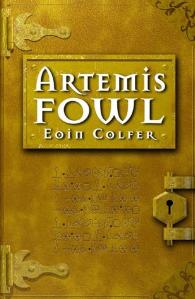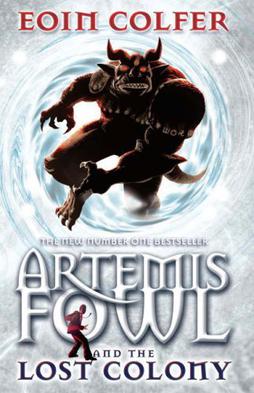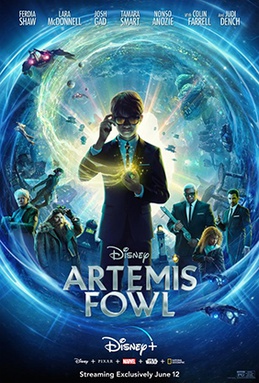Plot
Prior to the events of the first book, Artemis's father, Artemis Fowl I, imperils the family fortune by investing "a huge chunk of the Fowl fortune in establishing new shipping lanes" to Russia, following the breakdown of Communism there. The Russian Mafia retaliates by sinking a shipping vessel Artemis I was travelling on, the Fowl Star, leading to his disappearance, the loss of a substantial amount of the Fowl fortune, and the mental breakdown of his wife Angeline Fowl, Artemis's mother. [4]
In Artemis Fowl, which is set two years after those events, the 12-year-old Artemis decides to regain the Fowl fortune by following leads on the Internet that refer to an underground world of fairies collectively called the People. Artemis manages to blackmail a member of the People into giving him what they call "the Book" which is like their Bible, holding all their secrets, customs, rules, and history. This leads him to ransom Lower Elements Police (LEP) Captain Holly Short for a portion of the People's gold. Artemis and Holly agree to a deal whereby Holly retains half the ransom fee, while Artemis gets one wish from Holly and gets to keep the other half of the gold. After recovering Holly, the LEP attempt to permanently eliminate Artemis by setting off a biological weapon, but are thwarted when Artemis discovers a way around their attack (something not even the People had been able to develop).
In the sequel, The Arctic Incident , the 13-year-old Artemis learns that his father was only injured in the attack on his shipping vessel, and is being held hostage by the Russian Mafia. Artemis barters with the People to receive their aid in rescuing his father in exchange for assisting them in solving the mystery of who was behind a goblin rebellion. It is later revealed that Opal Koboi, a pixie criminal mastermind, and ex-LEP officer Briar Cudgeon are behind the plot. Their plan is thwarted, ending in Cudgeon's death and Koboi's arrest, and Artemis successfully recovers his father. [5]
In the third book, The Eternity Code , Artemis (in what he considers to be his last criminal act before his father recovers from his injuries) creates the C Cube, a mini super-computer based on the People's technology that is decades ahead of human technology. He plans to make a deal with Chicago technology businessman Jon Spiro over the Cube, but Spiro double-crosses Artemis, steals the Cube, and wounds Domovoi Butler in the process. Along with Holly Short and Foaly, Artemis succeeds in healing Butler and ensuring that Spiro does not discover the existence of the People through use of the C Cube. The C Cube is recovered, with the help of Foaly, Holly, Juliet (Butler's sister), and Mulch. But to gain the help of Foaly, Holly, and their Fairy technology, Artemis has to agree to Butler's, Juliet's and his own memories being wiped by the People, to avoid future misadventures. This happens at the end of the book. [6]
In the fourth book, The Opal Deception , Opal Koboi, who had been lying in an institution in a faked catatonic state, escapes with the help of pixie twins Mervall and Descant Brill, and begins plotting revenge against Julius Root, Holly Short, Foaly, and Artemis. Opal frames Holly for the murder of Julius Root and nearly terminates the now 14-year-old Artemis and Butler with a biological weapon. Holly rescues Artemis after being injured while escaping Opal's weapon. But Opal still seeks revenge on Holly and Artemis, so she traps them in an abandoned amusement park (comprising copies of the Seven Wonders of the Ancient World plus four extra monuments determined by the People) with only hungry trolls for company. Meanwhile, Mulch Diggums has helped Butler regain his memories and together they save Holly and Artemis in the nick of time and also return Artemis's memory. With help from Artemis, Butler, and Mulch, Holly prevents Opal from achieving her goal to uncover the Fairy People to humans. [7]
In the fifth book, The Lost Colony , Artemis works with the People to recover a young kidnapped demon imp from the 12-year-old child prodigy Minerva Paradizo. The team succeed in finding and rescuing the imp-warlock, but Artemis and Holly Short must then work to restore the imp's home, a floating island lost in a space and time Limbo, which threatens to breach its way onto Earth. In the process, several significant changes occur within the characters' lives. Artemis receives a small amount of magical power during the trip to Limbo, and swaps an eye with Holly on the return trip. The pair finds that they have been transported nearly three years into their future. Finally, Artemis learns that in the ensuing time he has become the older brother to twins, Beckett and Myles Fowl. [8]
In the sixth book, The Time Paradox , Artemis' mother Angeline Fowl becomes gravely ill with a rare fairy disease called Spelltropy. Artemis attempts to cure her with his remaining magic, but it only serves to worsen her condition. The only cure for Spelltropy is found in the brain fluid of the Silky Sifaka Lemur, the last of which Artemis sold in a business deal when he was ten years old, resulting in the extinction of the species. To get Holly to help him, Artemis falsely accuses her of exposing his mother to magic, which led to her developing the disease. Holly believes Artemis and, ridden with guilt, accompanies him to the past to rescue the last lemur from his younger self. After several misadventures, Artemis recovers the lemur but learns that his mother's illness was a ruse plotted by Opal Koboi, who wanted the lemur's brain fluid to increase her own magical powers. Artemis ruins Opal's plans by bringing his ten-year-old self into the present and fooling Opal, saving his mother in the process. Opal flees, but returns again as Artemis appears to take the lemur and fly off the manor's grounds in his Cessna. She chases him, following the thermal read of the lemur and slowly destroying the plane until it crashes on the shoreline. At the crash site, the two stand off until she discovers that the lemur is actually only a decoy, fitted with a thermal read to trick Opal. Before she can further injure Artemis, he shoots the boulder she's on, and it is shown that it was in fact the shell of a kraken she stood on, built up with gases that exploded with the pressure of Artemis's shot. The LEP team later informs Artemis that Opal's body was not recovered from the rubble. As a result of Opal meddling with her mind, Angeline Fowl learns of Artemis' contact with the People, and she asks Artemis to tell her the truth. Artemis' 10-year-old self has his mind wiped by Nº1, but retains a brief memory of the existence of fairies, [9] which spurs him to research them, ultimately leading to the events of the first book.
In the seventh book, The Atlantis Complex , Artemis contracts a mental disease called Atlantis Complex disease, similar to OCD, and now has an alter-ego named Orion, who is in love with Holly Short, and has a strange fascination with bivouacking. Due to the disease, Artemis finds himself obsessed with the number 5 and fearing the number 4 (which in Chinese sounds like the word for death). The disease worsens throughout the novel, leading to his distrust of close friends. A neutrino shock from Holly Short frees Artemis' alter-ego Orion but he comes back after being knocked out by a buzz baton blow from Holly. He later undergoes Atlantis Complex Disease treatment by the fairies, curing him and restoring his former self.
In the eighth book, The Last Guardian , Artemis must save humankind by stopping the crazed pixie Opal Koboi. Opal kills her younger self (who followed Artemis and Holly to the present in the sixth book) to gain enough black magic to open a magical gate, which has been under the Fowl Manor for a millennium, and so release the Berserkers (ancient fairy warriors). Then Artemis must fight his brothers, who have been taken over by the Berserker souls. He sacrifices himself at the conclusion of the book to trigger an ancient spell that disperses Opal and her various fairy spirits, but since his spirit was human (apart from some traces of fairy magic from Holly's borrowed eye), his essence endures at the location of the spell long enough for Holly and Foaly to clone a new body for him and transfer his soul into it. Although the process leaves him with missing memories, the book ends with Butler, Holly and Foaly immediately beginning work to restore them.
In The Fowl Twins—the first of a series of novels focusing on Artemis's younger twin brothers Beckett and Myles—it is mentioned that Artemis is currently six months into a five-year mission to Mars in a wind-up rocket he built in the family barn. He is accompanied by Butler, but has left his younger brothers Beckett and Myles under the 'guardianship' of NANNI, an artificial intelligence he created from combining his and Holly's brainwaves, with Artemis' intelligence and Holly's voice and mannerisms. Holly herself has now been promoted to Commodore and appears at the end of the novel, the narrative observing that a combined grin and grimace is a traditional expression for anyone who spends prolonged time with the Fowls. In the third book, The Fowl Twins Get What They Deserve, Minerva Paradizo mentions that prior to meeting her sprite husband and having a daughter with him, she and Artemis had briefly explored a relationship. Artemis himself remains in space for the remainder of the series.













